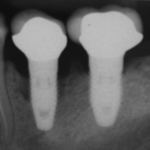
Peri-implantitis is a biofilm-associated pathological condition of the tissues around dental implants. It is characterised by inflammation of the peri-implant mucosa and subsequent progressive loss of the supporting bone. A recent review (Dental Elf – 24th Oct 2022) estimated a patient level prevalence for peri-implantitis of 20% (95%CI; 16.6 to 23.7%). Studies have suggested that non-surgical approaches have limited efficacy and surgical approach with or without reconstruction may deliver better outcomes.
The aim of this review was to assess the efficacy of different bone reconstructive therapies compared to access flap surgery at 12 months or longer for patients with peri-implantitis.
Methods
A protocol was registered in the PROSPERO database. Searches were conducted in the Medline, Embase, Cochrane Library, Web of Science, www.theses.com, OpenGrey, clinicaltrials.gov databases supplemented by hand searches of the most recent 2 years of the journals, Journal of Clinical Periodontology, Clinical Oral Implants Research, Journal of Periodontology, Journal of Dental Research, Journal of Clinical Investigation, and Clinical Implant Dentistry and Related Research. Randomised controlled trials (RCTs), clinical controlled trials (CCTs) and prospective case series (PCS) of reconstructive treatment for peri-implant bony defects using bone substitutes or grafts, barrier membranes, bioactive agents, or combinations using a well-defined criteria for peri-implantits were considered. The primary outcomes were change in probing pocket depth (PPD), bleeding on probing (BOP), and suppuration on probing (SOP). Two reviewers independently screened and selected studies and extracted data. Risk of bias was assessed by one reviewer using either the Cochrane Risk of Bias In Non-randomized Studies of Interventions (ROBINS-I) tool or risk-of-bias tool for randomised trials (RoB 2). Meta-analysis was conducted where more than 3 studies were identified.
Results
- 26 articles reporting on 12 RCTs (17 articles), 1 CCT (3 articles), and 5 prospective case series (6 articles) were included.
- 7 RCTs (9 articles) involving 194 patients (200 implants) assessed the efficacy of reconstructive surgery compared to AFS at 12 months.
- Of these 7 RCTs, 3 were at high risk of bias and 4 had some concerns.
- Meta-analysis (7 studies) of difference in PPD change between access flap surgery and reconstructive surgery at 12 months demonstrated no difference, -0.15mm (95%CI; -0.57 to 0.28mm).
- Meta-analyses (4 studies) of the difference between mean probing pocket depth changes under access-flap surgery (AFP) and reconstructive surgery found no significant difference, -39 mm (95%CI; -1.16 to 0.38 mm).
- Meta-analyses (4 studies) for changes in radiographic mean bone levels showed a statistically significant difference between AFS and reconstructive surgery of, 0.75mm (95%CI; –1.391 to 0.109 mm)
- 5 RCTs (8 articles) and 6 PCS (9 articles) assessed the efficacy of reconstructive peri-implantitis therapy at ≥12 months.
- One of the 5 RCTs was considered to be at low risk of bias, 2 at high risk and 2 had some concerns. All 6 PCS were considered to be at high risk of bias.
- Meta-analysis could not be performed owing to the heterogeneity of the reconstructive therapies performed, which included different types of graft alone or combined with different types of resorbable membranes and/or bioactive factors or local antibiotics.
Conclusions
The authors concluded: –
Reconstructive surgery does not offer significant improvements in peri-implant clinical parameters as compared to AFS at 12 months. It was not possible to establish a hierarchy of efficacy among the different biomaterials employed for reconstructive surgery.
Comments
The reviewers registered their protocol on PROSPERO dividing their core question about the effectiveness of reconstructive therapies for peri-implantitis into two, those focussed on studies with a minimum of 12 months follow up and those with follow-up periods of greater than 12 months. A broad databases search was used which was supplemented by hand searches of recent relevant journals. Twenty-six articles were included reporting on 18 studies as separate articles has reported on different outcomes and follow up periods which increases the challenges for readers and systematic reviewers. Twelve of the studies were RCTs and these all contributed to the meta-analyses however, only one of the 12 RCTs was at low risk of bias. The studies were also varied in the type of peri-implant defects, biomaterials and the surgical protocols used. The authors also highlighted variation regarding supportive care programmes and use of systemic antibiotics. The review authors have provided a wealth of detail in this review however the certainty of the available evidence is very low. With increasing numbers of implants being placed and an estimated 20% prevalence of peri-implantitis there is a need for high quality evidence for the prevention and management of the condition high quality well conducted and reported studies reporting on common outcomes including patient orientated outcomes are needed.
Links
Primary Paper
Donos N, Calciolari E, Ghuman M, Baccini M, Sousa V, Nibali L. The efficacy of bone reconstructive therapies in the management of peri-implantitis. A systematic review and meta-analysis. J Clin Periodontol. 2023 Jan 12. doi: 10.1111/jcpe.13775. Epub ahead of print. PMID: 36635029.
Other references
Dental Elf – 24th Oct 2022
Dental Elf – 19th Oct 2022
Peri-implantitis – Surgical treatment with or without adjunctive graft material
Dental Elf – 6th Sep 2019
Peri-implant disease: Does supportive periodontal treatment improve implant survival?
Picture credits
By Coronation Dental Specialty Group[1] – Own work, CC BY-SA 3.0.
